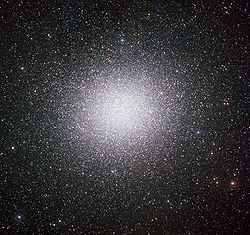
Below is a list of the largest known star clusters , ordered by diameter in light years, above the size of 50 light years in diameter. This list includes globular clusters, open clusters, super star clusters, and other types.

Below is a list of the largest known star clusters , ordered by diameter in light years, above the size of 50 light years in diameter. This list includes globular clusters, open clusters, super star clusters, and other types.
| Cluster name | Diameter (light-years) | Type of cluster | Notes |
|---|---|---|---|
| Palomar 12 | 324 [1] | Globular cluster | Associated with the Sagittarius Stream, possibly captured from the Sagittarius Dwarf Spheroidal Galaxy. Might be the largest star cluster in the Milky Way. |
| Terzan 7 | 316 [2] | Within the main body of the Sagittarius Dwarf Spheroidal Galaxy. | |
| Messier 54 | 306 [3] | The brightest globular cluster of the Sagittarius Dwarf Spheroidal Galaxy, appears to reside at its core. | |
| NGC 339 | 238 [4] | Located in the Small Magellanic Cloud. | |
| Messier 3 | 226 [5] | Quite isolated at 31.6 kly (9.7 kpc) above the Galactic plane and roughly 38.8 kly (11.9 kpc) from the center of the Milky Way. | |
| Messier 11 (Wild Duck Cluster) | 190 [6] | Open cluster | |
| Messier 2 | 174.4 [7] | Globular cluster | In the southern galactic cap of the Milky Way's galactic halo. |
| Omega Centauri | 172 ± 12 [8] | Might be the largest globular cluster in the Milky Way. [9] Possibly a core of an absorbed dwarf galaxy. [10] | |
| Messier 13 | 168 [11] | ||
| Messier 15 | 166 [12] | ||
| Palomar 5 | 152 [13] | ||
| Messier 75 | 126 [14] | ||
| 47 Tucanae | 120 [15] | ||
| Messier 68 | 106 [16] | ||
| Messier 22 | 100 ± 10 [17] | One of the first star clusters ever discovered. [18] | |
| Messier 14 | 100 [17] | ||
| Messier 62 | 98 [19] | ||
| Messier 55 | 96 [20] | ||
| NGC 265 | 94 [21] | Open cluster | |
| Messier 69 | 90 [22] | Globular cluster | |
| Messier 9 | 90 [23] | ||
| Messier 56 | 84 [24] | ||
| Messier 10 | 83.2 [25] | ||
| NGC 3201 | 80 [26] | ||
| Messier 107 | 79 [27] | ||
| Messier 46 | 75.6 [28] | Open cluster | |
| Messier 4 | 75 [29] | Globular cluster | Nearest globular cluster to the Earth. Also the first globular cluster known to have exoplanets (PSR B1620-26b) |
| Messier 12 | 74.4 [30] | ||
| Messier 70 | 68 [31] | ||
| NGC 290 | 66 [32] | Open cluster | |
| Messier 28 | 60 [33] | Globular cluster | |
| Messier 18 | 52.4 [34] | Open cluster | |
| The following notable star clusters are listed for the purpose of comparison. | |||
| MGC1 | 49 (half-light), 7,800 (tidal) [35] | Globular cluster | |
| Mayall II | 42±1 (half-light), 526±25.4 (tidal) [36] | ||
| Pleiades | 40.68 [37] | Open cluster | Nearest Messier Object to Earth and the easiest to see in the night sky. |
| RSGC2 (Stephenson 2) | 26.1 [38] | ||
| Alpha Persei cluster | 22.8 [39] | ||
| Jewel Box | 20 [40] | ||
| Hyades | 17.6 [41] | Nearest open cluster | |
| Beehive Cluster (Praesepe) | 15 [42] | ||
| RSGC1 | 9.78 ± 1.96 [43] | ||
| Westerlund 1 (Ara Cluster) | 6.52 [44] | Super Star Cluster/Open cluster | |